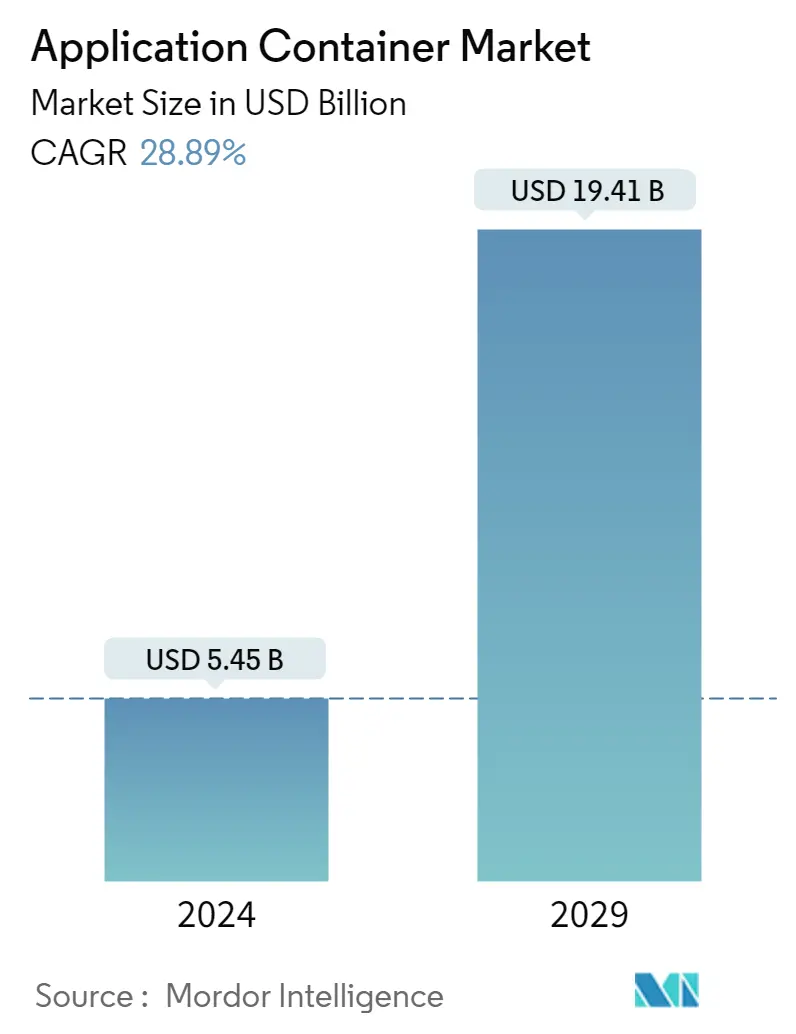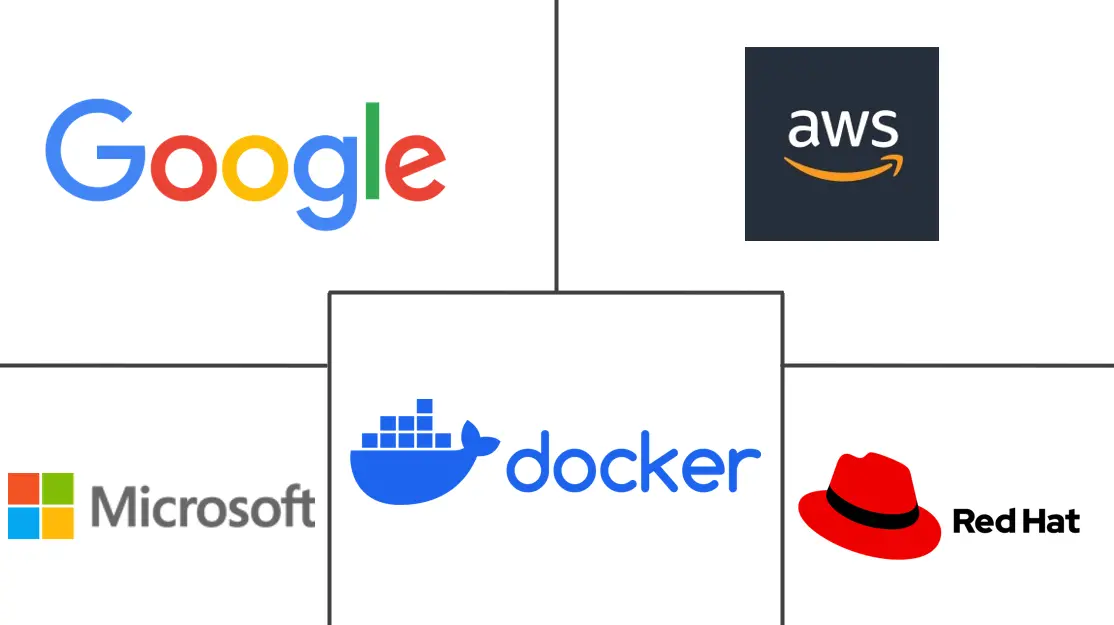Market Size of Application Container Industry

| Study Period | 2019 - 2029 |
| Market Size (2024) | USD 5.45 Billion |
| Market Size (2029) | USD 19.41 Billion |
| CAGR (2024 - 2029) | 28.89 % |
| Fastest Growing Market | Asia Pacific |
| Largest Market | North America |
Major Players
*Disclaimer: Major Players sorted in no particular order |
Application Container Market Analysis
The Application Container Market size is estimated at USD 5.45 billion in 2024, and is expected to reach USD 19.41 billion by 2029, growing at a CAGR of 28.89% during the forecast period (2024-2029).
The market is anticipated to witness a steady rise in the number of containerized applications as businesses deploy their applications using containers on a regular basis. The numerous advantages of containers, such as their simplicity in packaging and deploying programs, their capacity to execute the same application across multiple environments, and their rapid and effective scalability, will be the driving force behind this movement. Moreover, the CNCF's 2022 study found that 44% of participants utilize containers for most or all production applications. Kubernetes is used to deploy at least some containers in production by half of those that utilize containers.
- The application container market has witnessed substantial growth and transformation in recent years. Application containers have become a critical technology in software development and deployment, offering a lightweight and efficient way to package, deploy, and manage applications. Several notable trends have driven the application container market in recent years. One of the most prominent trends is the adoption of hybrid and multi-cloud strategies. Organizations are increasingly leveraging containers to achieve flexibility and portability across diverse cloud providers and on-premises infrastructure, thus reducing vendor lock-in and enhancing adaptability to changing needs.
- Many organizations are leveraging containers to modernize their legacy apps, streamline infrastructure, and to be able to market their innovations faster. Containers primarily help speed up the applications to market because they offer faster, more consistent release cycles. The application is therefore developed in a container, packaged, tested, and deployed into production. As the application is already being tested in a runtime environment, there is no need for additional testing. Also, much less troubleshooting is required as containers are built to restart when they detect a failure.
- Several factors drive the application container market. Efficiency and portability are key drivers, as containers provide a consistent and efficient way to package applications, reducing compatibility issues and ensuring portability across different environments. Scalability is another critical driver, allowing organizations to adjust to varying workloads rapidly and user demands while optimizing resource utilization and reducing costs. The alignment of containers with DevOps and Agile methodologies promotes rapid development and deployment, enhancing an organization's competitiveness in a dynamic marketplace.
- Moreover, In October 2023, Sysdig and Docker announced the integration of Sysdig runtime insights into Docker Scout inorder to help developers prioritize risk and move faster. Docker and Sysdig will help customers reduce software supply chain noise, prioritize the insights that matter, and build leaner container images. Sysdig is the first runtime security integration into Docker Scout.
- However, containers can be more vulnerable to certain security risks, such as kernel exploits and shared resources vulnerabilities. Organizations are looking to implement robust security measures, and misconfigurations or supervised security practices can lead to significant security breaches. Also, managing containers at scale can be complex, especially in large enterprise environments. Organizations are expected to implement container orchestration tools like Kubernetes, including networking, storage, and other infrastructure components, which can introduce complexity and require specialized expertise.
- The COVID-19 pandemic imposed remote working scenarios, which have highlighted the importance of the cloud for business continuity with remote workforces and smooth online communication. Any enterprise's journey toward cloud transformation includes a container strategy. Numerous businesses adopted a container-first strategy because of the flexibility and cost savings that application containers provide, which is creating a demand for the market in the post-pandemic phase.
Application Container Industry Segmentation
The Application Container is a standard unit of software that packages up code and all its dependencies so that the applications run quickly and reliably from one computing environment to another. Application containers consume fewer resources than a comparable deployment on virtual machines because containers share resources without a full operating system to underpin each app. Containers are software packages that come with everything needed to execute in any environment. Containers virtualize the operating system in this manner, enabling them to run anywhere, even on a developer's personal laptop or on a public cloud.
Application container market is segmented by deployment type (on-premises, cloud), organization size (small and medium enterprises [SMEs], large enterprises), service (container monitoring & security, container data management & orchestration, container networking, container support & maintenance), industry vertical (BFSI, healthcare and life science, telecommunication and IT, retail and e-commerce, education, media and entertainment) and geography (North America (United States, Canada), Europe (United Kingdom, Germany, France, Spain, Rest of Europe), Asia-Pacific (China, India, Japan, Rest of Asia-Pacific), Latin America (Brazil, Argentina, Mexico, Rest of Latin America), Middle East and Africa (United Arab Emirates, Saudi Arabia, South Africa, Rest of Middle East and Africa)).The market sizes and forecasts are provided in terms of value in USD for all the above segments.
| By Deployment Type | |
| On-Premises | |
| Cloud |
| By Organization Size | |
| Small and Medium Enterprises (SMEs) | |
| Large Enterprises |
| By Service | |
| Container Monitoring & Security | |
| Container Data Management & Orchestration | |
| Container Networking | |
| Container Support & Maintenance | |
| Other Services |
| By Industry Vertical | |
| BFSI | |
| Healthcare and life science | |
| Telecommunication and IT | |
| Retail and e-commerce | |
| Education | |
| Media and entertainment | |
| Others (manufacturing, utilities, transportation and logistics, travel and hospitality, and government) |
| By Geography | |||||||
| |||||||
| |||||||
| |||||||
| |||||||
|
Application Container Market Size Summary
The application container market is experiencing significant growth, driven by the increasing adoption of containerization technologies in software development and deployment. Containers offer numerous advantages, including simplified packaging and deployment, cross-environment compatibility, and rapid scalability, making them an attractive choice for businesses looking to modernize their applications and infrastructure. The market is further propelled by the trend towards hybrid and multi-cloud strategies, which provide organizations with the flexibility and portability needed to navigate diverse cloud providers and on-premises infrastructure. This shift is reducing vendor lock-in and enhancing adaptability to evolving business needs. The alignment of containers with DevOps and Agile methodologies is also contributing to market expansion, as they facilitate faster, more consistent release cycles and support rapid development and deployment processes.
The North American region is poised to capture a significant share of the application container market, fueled by the region's robust adoption of cloud services and the growing demand for DevOps. The presence of numerous startups and established players offering container solutions, along with financial investments in container technology, is creating ample opportunities for market growth. Organizations in this region are increasingly adopting containers to accelerate software delivery and embrace cloud flexibility. The market is highly competitive, with major players like Amazon Web Services, Google LLC, and Microsoft Corporation leading the charge. Innovations and strategic partnerships, such as those between Kyndryl and Red Hat OpenShift, are further driving the market's dynamic landscape, enabling businesses to enhance their cloud transformation efforts and optimize their application deployment processes.
Application Container Market Size - Table of Contents
-
1. MARKET INSIGHTS
-
1.1 Market Overview
-
1.2 Industry Value Chain Analysis
-
1.3 Industry Attractiveness - Porter's Five Force Analysis
-
1.3.1 Bargaining Power of Suppliers
-
1.3.2 Bargaining Power of Buyers/Consumers
-
1.3.3 Threat of New Entrants
-
1.3.4 Threat of Substitute Products
-
1.3.5 Intensity of Competitive Rivalry
-
-
1.4 Assessment of the Impact of COVID-19 on the Market
-
-
2. MARKET SEGMENTATION
-
2.1 By Deployment Type
-
2.1.1 On-Premises
-
2.1.2 Cloud
-
-
2.2 By Organization Size
-
2.2.1 Small and Medium Enterprises (SMEs)
-
2.2.2 Large Enterprises
-
-
2.3 By Service
-
2.3.1 Container Monitoring & Security
-
2.3.2 Container Data Management & Orchestration
-
2.3.3 Container Networking
-
2.3.4 Container Support & Maintenance
-
2.3.5 Other Services
-
-
2.4 By Industry Vertical
-
2.4.1 BFSI
-
2.4.2 Healthcare and life science
-
2.4.3 Telecommunication and IT
-
2.4.4 Retail and e-commerce
-
2.4.5 Education
-
2.4.6 Media and entertainment
-
2.4.7 Others (manufacturing, utilities, transportation and logistics, travel and hospitality, and government)
-
-
2.5 By Geography
-
2.5.1 North America
-
2.5.1.1 United States
-
2.5.1.2 Canada
-
-
2.5.2 Europe
-
2.5.2.1 United Kingdom
-
2.5.2.2 Germany
-
2.5.2.3 France
-
2.5.2.4 Spain
-
2.5.2.5 Rest of Europe
-
-
2.5.3 Asia-Pacific
-
2.5.3.1 China
-
2.5.3.2 India
-
2.5.3.3 Japan
-
2.5.3.4 Rest of Asia-Pacific
-
-
2.5.4 Latin America
-
2.5.4.1 Brazil
-
2.5.4.2 Argentina
-
2.5.4.3 Mexico
-
2.5.4.4 Rest of Latin America
-
-
2.5.5 Middle East and Africa
-
2.5.5.1 United Arab Emirates
-
2.5.5.2 Saudi Arabia
-
2.5.5.3 South Africa
-
2.5.5.4 Rest of Middle East and Africa
-
-
-
Application Container Market Size FAQs
How big is the Application Container Market?
The Application Container Market size is expected to reach USD 5.45 billion in 2024 and grow at a CAGR of 28.89% to reach USD 19.41 billion by 2029.
What is the current Application Container Market size?
In 2024, the Application Container Market size is expected to reach USD 5.45 billion.

